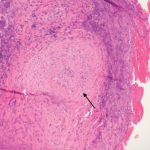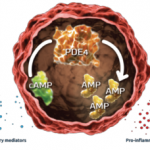During her hospitalization, the patient developed an acute kidney injury, with her creatinine rising to 2.1 mg/dL from 0.7 mg/dL on presentation. Further laboratory testing revealed an elevated erythrocyte sedimentation rate (ESR) of 78 mm/hr (ref: 0–20) and C-reactive protein (CRP) of 12.7 mg/L (ref: 0.1–3.0), a rheumatoid factor of 41 IU/mL (ref: <14) and a positive C-ANCA with a titer >1:160.
The patient’s presentation with pulmonary hemorrhage, acute kidney injury and high C-ANCA titer led to a diagnosis of GPA. She was treated with pulse dose steroids for three days and concurrently started on plasma exchange, of which two cycles were completed. She was then placed on 240 mg/day of methylprednisolone.
Twelve days after her initial presentation, the patient was transferred to our institution to obtain a renal biopsy. On arrival, she was intubated and afebrile with a heart rate of 123 beats per minute and a blood pressure of 143/72 mmHg. Examination demonstrated a III/VI systolic murmur heard across the precordium, as well as splinter hemorrhages and purpuric periungual lesions in several bilateral fingers and toes, and peripheral edema in bilateral upper and lower extremities.
Her laboratory studies were notable for a total leukocyte count of 21,000 cells/μL and a creatinine of 2.0 mg/dL. Her complement levels were decreased, with a C3 of 31 mg/dL (ref: 81–145) and C4 <10 mg/dL (ref: 16–39), but her C1Q was 14 mg/dL (ref: 12–22), which was within normal range. Her ESR was 4 mm/hr (ref: 0–20), CRP was 14 mg/L (ref: 0.1–3.0), and fibrinogen was 83 mg/dL (ref: 144–436). Her ANCA screen was positive for C-ANCA, with a titer of 1:80 (ref: <1:20) and a PR3 antibody level of 606.9 CU (ref: <20). Her rheumatoid factor level was elevated at 18 IU/mL (ref: <15.9). Tests for ANA, anti-cardiolipin antibodies, anti-beta-2 glycoprotein antibodies and anti-glomerular basement membrane (GBM) antibodies were negative. A urinalysis revealed cloudy urine with a specific gravity of 1.012, 1+ protein, 3+ blood, and three to five red blood cells per high-power field. Further urine testing revealed a urine protein to creatinine ratio of 1.31.
A chest X-ray demonstrated hazy perihilar opacities and small bilateral pleural effusions, and a chest CT scan demonstrated an upper lobe predominant diffuse opacification that was consistent with pulmonary hemorrhage (see Figure 1). The patient was continued on a one-month antibiotic regimen of vancomycin and ceftriaxone and also maintained on 240 mg/day of methylprednisolone. Further immunosuppressive agents were not started due to concern for infective endocarditis.

